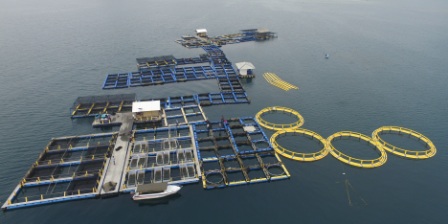VANAME SHRIMP CULTIVATION IN AQUATEC HDPE FLOATING MARINE CAGES IN BBPBL LAMPUNG

Having an eye for good potentials, the Lampung BBPBL has successfully developed the cultivation of Pacific White Shrimp (Vaname Shrimp) in HDPE cages
The Marine Cultivated Fisheries Major Association (BBPBL) of Lampung has made a breakthrough in cultivating Pacific white shrimp in HDPE floating marine cages.
We can say that it’s not a common thing for BBPBL of Lampung to cultivate shrimp in HDPE floating marine cages. According to Herno Minjoyo, the main engineer of Lampung BBPBL, the main reason why they decide to develop the Pacific white shrimp cultivation is due to the vast potential of the Indonesian waters which makes large scale Vaname shrimp marine cultivation possible.
 Other than looking at the potential of marine resources in Indonesia, the BBPBL of Lampung has also considered cost efficiency. Apparently, the marine cultivation of Pacific white shrimp does not require the use of water mill and electricity, hence it can lower down cost significantly.
Other than looking at the potential of marine resources in Indonesia, the BBPBL of Lampung has also considered cost efficiency. Apparently, the marine cultivation of Pacific white shrimp does not require the use of water mill and electricity, hence it can lower down cost significantly.
In order to increase society’s welfare, Herno’s hope is for the coastline people to start cultivating Pacific white shrimp in marine cages because the pond cultivations have been disrupted by the activities of deforestation of mangrove trees.
For the marine cultivation of Pacific white shrimps, BBPBL of Lampung is using rectangular HDPE marine cages from Aquatec which is the result of combined research on vaname shrimp between Ir. Coco Kokarkin Soetrisno, M. Sc and Aquatec in 2012, and was given by KKP since 2015.
The Aquatec marine cage is one of the featured domestic products, made from Prime Grade High Density Polyethylene (HDPE) with anti-UV, designed to be strong and flexible to withstand ocean waves up to 2 meters high. “By using high quality Aquatec marine cages, users can concentrate in increasing productions instead of worrying that the marine cages will break”, Said Coco, the Director of Feeds of the Directorate General of KKP Cultivated Fisheries. Aquatec marine cages has been classified environmental friendly for cultivation products export to Europe.
BBPBL Lampung has been advancing the cultivation of Pacific white shrimp in HDPE marine cages since 2015, and has continuously been conducting research and development until now. In year 2015, BBPBL Lampung has also spread information and provided examples on cultivating Pacific white shrimp to the people in Lampung bay area. With that, BBPBL Lampung is playing an important role in developing the business of vaname shrimp cultivation in Lampung.
Currently, BBPBL Lampung owns 20 HDPE marine cage holes, specifically for Pacific white shrimp cultivation, with the size of 3×3 each. According to Herno, cultivation of Pacific white shrimp in HDPE marine cage is very profitable, and would recommend for shrimp cultivators to own 20-25 holes. “The reason is because the minimum scale to cover surveillance and maintenance fee, and to reach BEP, is about 4-8 holes. Therefore, adding another hole will definitely bring profit”, explained Herno.
Things which requires attentions
Other than the spread density, depth of the net, and the size of the seed for spreading, the location of the marine cage is also important in cultivating Pacific white shrimp. The best location should be in a protected area, such as the Bay area, where it’s easier to maintain and control.
Marine cage should not be positioned too close to each other or close to ponds because it can be affected by the activities of ponds waste or infected by other marine cages nearby. The best depth for the net should be about 2M, which has a survival rate (SR) of 75%. If the depth of the net is about 3-4M, it will not be efficient because it will only increase the number of productions but with SR of 65% and 52% only.
Herno explained that the spread density for fingerlings or PL (post Larva) 40 is about 75-125 shrimp/m3 with a net size of 4 x 11 x 3m. Spreading PL (post larva) with density of 10 is for about 100-150 shrimp/m3 preserved inside a net with the size of 2,5 x 3,5 x 2,5m, and covered by 4 x 11 x 3m net.
Herno suggested to spread the shrimp in marine cage PL 40, where you can buy fingerling from land or first make fingerlings from hatchery and then spread it, or breed the fingerlings in hapa (a net with mesh size of 2,5 x 3,5 x 2,5m). The net has to be replaced once every three weeks, with the feeding frequency of 6 times a day.
Pacific white shrimp in marine cages is reared with high level of salinity. It takes maximum of 3 months or 90 days of time to rear fingerling or PL 40. However, sometimes it only takes 80 days or 87 days until harvest time. On the other hand, the rearing of PL 10 takes about 4 months.
 In Pacific white shrimp cultivation, a harvest size of 40, 44, 45 can be obtained if the spread density is low. If the spread density of fingerlings reaches 75 shrimp/m3, the harvested shrimp size could reach 53.49. In regards to harvest, a vaname shrimp with a size of 100 is already considered as consumable shrimp at the market. The pacific white shrimp cultivation in HDPE cages is expected to revolutionize shrimp production in Indonesia.
In Pacific white shrimp cultivation, a harvest size of 40, 44, 45 can be obtained if the spread density is low. If the spread density of fingerlings reaches 75 shrimp/m3, the harvested shrimp size could reach 53.49. In regards to harvest, a vaname shrimp with a size of 100 is already considered as consumable shrimp at the market. The pacific white shrimp cultivation in HDPE cages is expected to revolutionize shrimp production in Indonesia.































